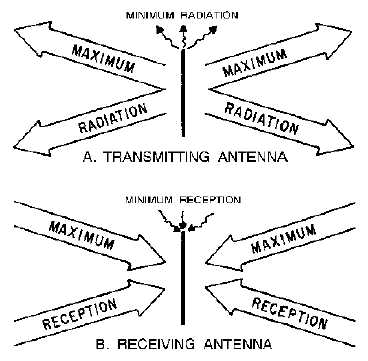4-9
Figure 4-7.—Reciprocity of antennas.
ANTENNA GAIN
Another characteristic of a given antenna that remains the same whether the antenna is used for
transmitting or receiving is GAIN. Some antennas are highly directional that is, more energy is
propagated in certain directions than in others. The ratio between the amount of energy propagated in
these directions compared to the energy that would be propagated if the antenna were not directional is
known as its gain. When a transmitting antenna with a certain gain is used as a receiving antenna, it will
also have the same gain for receiving.
POLARIZATION
Let's review polarization briefly. In chapter 2 you learned that the radiation field is composed of
electric and magnetic lines of force. These lines of force are always at right angles to each other. Their
intensities rise and fall together, reaching their maximums 90 degrees apart. The electric field determines
the direction of polarization of the wave. In a vertically polarized wave, the electric lines of force lie in a
vertical direction. In a horizontally polarized wave, the electric lines of force lie in a horizontal direction.
Circular polarization has the electric lines of force rotating through 360 degrees with every cycle of rf
energy.
The electric field was chosen as the reference field because the intensity of the wave is usually
measured in terms of the electric field intensity (volts, millivolts, or microvolts per meter). When a
single-wire antenna is used to extract energy from a passing radio wave, maximum pickup will result
when the antenna is oriented in the same direction as the electric field. Thus a vertical antenna is used for
the efficient reception of vertically polarized waves, and a horizontal antenna is used for the reception of
horizontally polarized waves. In some cases the orientation of the electric field does not remain constant.


